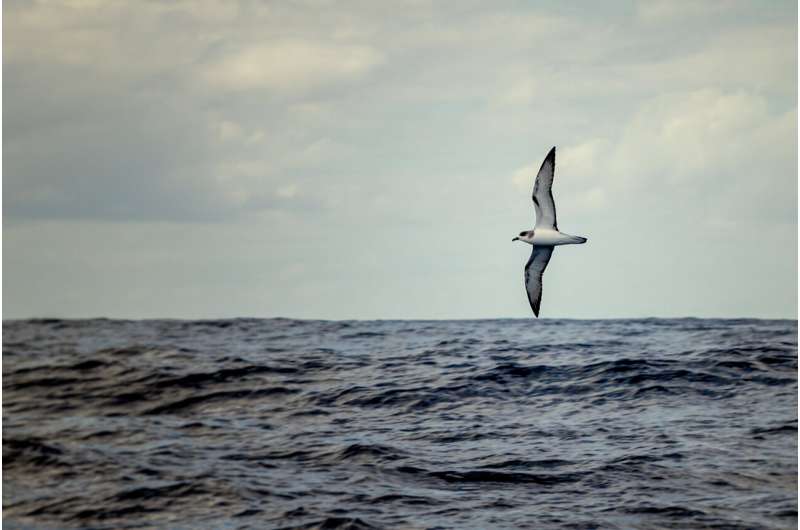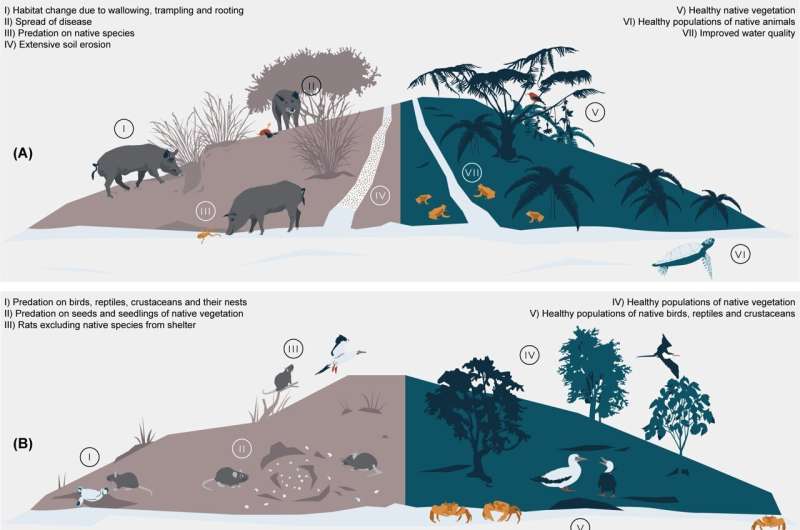New research shows people, wildlife, and marine environment benefit when island-ocean connections are restored

Restoring and rewilding islands that have been decimated by damaging invasive species provides benefits to not only the terrestrial ecosystem but to coastal and marine environments as well. Linking land and sea through coordinated conservation efforts may offer unrealized and amplified benefits for biodiversity, human well-being, climate resilience and ocean health, and provides a microcosm for the untapped potential of ecosystem restoration on a larger scale. This new era of conservation focuses on the interconnectedness of all ecosystems, rather than pursuing individual pieces through siloed efforts.
A new perspective published today, December 5, in the Proceedings of the National Academy of Sciences (PNAS) titled "Harnessing island–ocean connections to maximize marine benefits of island conservation" recognizes the critical link between island and marine ecosystems and identifies island and near-shore marine environmental characteristics that promote strong linkages in these ecosystems around the world. The result is a model for effective land-sea conservation and management decisions by governments, foundations, Indigenous peoples, local communities, NGOs and conservationists to harness the power of island-ocean connections that bolster ocean health.
"By applying this knowledge to islands worldwide, we can understand the marine benefits of island restoration projects and maximize returns for our conservation management investments for people, wildlife, and the planet," said Stuart A. Sandin, Ph.D., lead author of the perspective and a marine ecologist at Scripps Institution of Oceanography at the University of California San Diego.

Islands support some of the most valuable ecosystems on Earth, with a disproportionate amount of rare plants, animals, communities, and cultures found nowhere else. Healthy land-sea ecosystems depend on a flow of nutrients from oceans to islands and from islands to oceans, a process that "connector species," such as seabirds, seals, and land crabs, facilitate. Research shows that islands with high seabird populations, for example, which feed in the open ocean and bring large quantities of nutrients to island ecosystems through their guano deposits, are associated with larger fish populations, faster-growing coral reefs, and increased rates of coral recovery from climate change impacts.
Many seabird species, however, have been driven to local or global extinction or near-extinction due to invasive non-native mammals, such as rats that eat bird eggs and young hatchlings on islands where they nest. The loss of these connector species populations often results in ecosystem collapse–both on land and in the sea. Removing invasive species from islands is one of our best tools for restoring native plants, animals, and ecosystems.
"Islands and oceans are connected–something many people living along coasts have long understood, depended on and managed holistically as a result," said Penny Becker, Ph.D., a coauthor on the perspective and vice president of conservation for the nonprofit Island Conservation. "Linking efforts on land, including removing invasive species from islands, with marine restoration and protection offers a significant untapped opportunity to protect and restore both islands and coastal regions."
The insights put forward by the authorship collaboration of researchers, non-profit conservationists, government agency representatives, and others can help shape where the most impactful marine co-benefits of island restoration could occur. They highlight six essential environmental characteristics that can guide prioritization of island-ocean restorations: precipitation, elevation, vegetation cover, soil hydrology, oceanographic productivity, and wave energy.
The paper identifies islands with higher rainfall, lower wave energy, and other conditions consistent with high land–sea connectivity, such as Floreana Island in Ecuador's Galapagos Archipelago as having high potential to produce substantial marine co-benefits after invasive species removal and island rewilding.
"This research is incredibly useful for prioritizing where to focus conservation work and precious resources to have the greatest impact," said Wes Sechrest, Ph.D., co-author and chief scientist and CEO for the nonprofit Re:wild. "By restoring and rewilding Floreana Island, we now know that we will also be restoring and protecting wildlife in the Marine Protected Area surrounding the island and beyond, and providing climate resilience. This is critical to building a sustainable Floreana for local islanders and a healthier planet for all life on Earth."
Floreana residents have witnessed the negative effects of invasive species firsthand for decades and are shaping their island's future by playing a central role in its restoration.
Sonsorol Island, Palau is another site with high land-sea connectivity potential. The reduction in seabirds due to invasive species has significantly slowed nutrient deposition, which in turn is limiting the productivity of surrounding reefs. Sonsorol Island's remoteness means that the community depends heavily on the local resources available to them. Prior to the impacts of invasive species, Sonsorol Island residents lived harmoniously with their environment and thrived on the natural resources provided by the land and sea.
"Sonsorol and Floreana Island are just two of the many islands that hold great potential for healing marine environments," said Kate Brown, executive director of the Global Island Partnership and co-author. "Prioritizing island restoration across the globe can have a significant benefit for our world's biodiversity, both on land and in the sea. Together, we can build resilient island communities supported by healthy island and marine ecosystems teeming with biodiversity."
The Sonsorol and Floreana island restoration projects are part of an ambitious new environmental campaign called the Island-Ocean Connection Challenge, which aims to restore and rewild at least 40 globally significant island ecosystems to benefit islands, oceans, and communities by 2030.
More information: Sandin, Stuart A., Harnessing island–ocean connections to maximize marine benefits of island conservation, Proceedings of the National Academy of Sciences (2022). DOI: 10.1073/pnas.2122354119. doi.org/10.1073/pnas.2122354119
Journal information: Proceedings of the National Academy of Sciences
Provided by University of California - San Diego




















